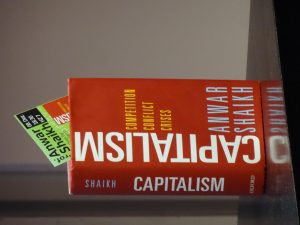Ideological Statistics: Inflated Death Rates of China's Famine, the Russian one Ignored
✑ UTSA PATNAIK | ± 10 minutes
The figure of 30 million deaths during China's famine has no scholarly basis whatsoever but passed into popular folklore. The demographic collapse in Russia in the first half of the 1990s has been met with a deafening silence.
The text above is an extract from a lecture from Utsa Patnaik given in 2004 titled The Republic of Hunger, focussed on malnourishment problems in India. This extract, on China and Russia, was included in the lecture as ‘international context of the discussion’. Read a more detailed critique by Patnaik of the estimates of Coale and Banister on China's death rates here.
NOTES
1 These death rates were presented in a paper on poverty in Russia, by Prof. P. Gregory, at an international workshop on country studies in poverty held at UNDP, New York on September 20, 1997 and attended by the author.
‟The entire field of the discussion of hunger and famine is a highly ideological one.
The figure of 30 million deaths during China's famine has no scholarly basis whatsoever but passed into popular folklore. The demographic collapse in Russia in the first half of the 1990s has been met with a deafening silence.
An extract from Patnaik's lecture "The Republic of Hunger" (2004).
|
|---|
About the author (click)
Utsa Patnaik is an Indian Marxist economist. She taught economics at the Jawaharlal Nehru University (JNU) in New Delhi and has written numerous books focussed on agrarian questions, food security and transitions from agricultural to industrial societies. Her most recent book: A Theory of Imperialism (2016), with co-author Prabhat Patnaik.
The alleged massive famine in China during the Great Leap, 1958-61, and the internationally unrecognized famine in Russia in the first half of the 1990s.
When we look at these cases it becomes clear enough that the entire field of the discussion of hunger and famine is a highly ideological one, and has been routinely characterized by the abandoning of the minimum academic criteria with respect to evidence and estimation.
First, let us consider the allegation that 27 to 30 million people died in China during the ‘Great Leap’ period. This allegation is contained in the books of two US demographers Ansley J Coale (1984), and Judith Banister (1987). Few in the developing world however would have bothered to read the discussion of these demographers, couched in technical language. The main popularizer and ardently uncritical supporter of the conclusions of these US demographers, has been Amartya K. Sen and it is through Sen’s writings first in the New York Review of Books and subsequently in his many lectures and books including Development as Freedom (1999) that the world, and the reading public in this country has been informed that “China has had what is almost certainly the largest recorded famine in history (when thirty million people died in the famine that followed the Great Leap Forward) in 1958-61) whereas India has not had a famine since independence in 1947 ” (Sen, 1999, 43). The figure of 30 million has passed into popular folklore. However, a study of how it has been arrived at shows that this estimate has no scholarly basis whatsoever.
The facts are that there was a run of three bad harvests and a steep 30% drop in foodgrains output took place in China in 1960, while the government’s procurement from the villages did not decline, lowering availability per head. The official death rate, which had been falling up to 1958 owing to public health and sanitation measures, registered a rise to 25.4 per thousand in 1960. (This peak ‘famine’ death rate in China was however little different from India’s actual, ‘normal’ death rate, 24.6, in the same year). The birth rate also fell steeply in 1958, mainly owing to labour mobilisation for collective work.
Two alternative routes have been used to estimate ‘famine deaths’, both of very dubious validity. In the first, the ‘missing millions’ totalling 27 millions in the population pyramid during 1958 to 1961, have been identified with ‘famine deaths’. The problem with this is that not only the people who were actually living and who died in excess of normal numbers are included in the missing millions, but so are all those hypothetical persons included, who were never born at all and who ‘should’ have been born if the birth rate had not fallen. This is not a common-sense definition nor is it a logical definition of famine deaths: for, to ‘die’ in a famine, a minimum necessary condition is to be born in the first place. The Chinese are a highly talented people but even they cannot achieve the feat of dying without being born. If a person is told that 30 million people died, then quite correctly she would infer that those 30 million were alive and then died. The fact that 19 million of them never existed because they were never born in the first place, is not conveyed by the formulation. Hence, there is disingenuousness involved in saying that 30 million people ‘died’: it is an untrue proposition.
If more people were born over the inter-censal period 1953 to 1964, correspondingly these extra people must also have died over the same period: for both authors despite rejecting every official vital rate, display a touching faith in the absolute Census population totals at these two dates. Hence the official increase in population is kept unchanged, enabling them to assume exactly as many extra deaths as they assume extra births. With this procedure the official figure of total deaths over the inter-censal period, was raised by a heroic 60 percent. Both authors then arbitrarily allocated the assumed higher numbers of deaths over the individual inter-censal years, by assuming varying rates by which deaths were allegedly ‘under-reported’ during each of these years. In short it was entirely up to the demographer how many extra deaths he or she assigned to the Great Leap years, and the totally arbitrary nature of the procedure can be gauged by the fact that Coale raised the 1960 death rate to nearly 39 while Banister raised it to 44.6 (compared to the official death rate of 25.4). There is no reasonable basis for either figure.
Nor is this all: a linear time trend was then fitted by both, to deaths derived from a variable - the death rate – which always behaves non-linearly, and the extent to which the (arbitrarily constructed) death rate was above this declining trend, was then used to derive total ‘excess deaths’, the figure being 27 million for Coale and 30 million for Banister. We know that deaths in a population can never reach zero, so fitting linear trends makes no sense. The linear trend procedure implies that the Chinese population would have reached zero deaths and attained immortality in a few years – a remarkable achievement indeed, an impossible achievement outside the nonsensical statistical procedures followed by the US demographers.
It is a travesty of the norms of academic integrity, that grossly exaggerated estimates of ‘famine’ deaths derived in this arbitrary manner have been uncritically quoted and promoted and that they enjoy so much currency. In my detailed critique (Patnaik 2002) I have also shown the inconsistency of the peak death rates constructed by Coale and Banister, with the foodgrains output and availability figures in China. My calculations also show that the lowest possible availability figures we can get for China after taking into account government procurement, is still higher than in India, and it is a puzzle why, given a much more egalitarian distribution, the death rate should have risen even to the officially declared level. Because the internal political developments in China after 1978 were in the direction of attacking Maoist egalitarianism and the commune system, no repudiation from Chinese sources of the US estimates are to be seen.
In sharp contrast to the retrospective, patently ideological construction of hypothetical large famine deaths in China’s Great Leap period and the publicizing of these figures, we find that the demographic collapse in Russia in the first half of the 1990s has been met with a deafening silence from the same academics. The estimation methods which they applied to China are not applied by them to Russia. The facts are that so-called ‘shock therapy’ to usher in capitalism, under the advice of Western experts, led to a catastrophic collapse of GDP in the former socialist states between 1990 and 1996. As Table 1 summarizing United Nations data shows, the GDP level was half or less in Russia and Ukraine by 1996 compared to a decade earlier and collapsed to only one-fifth of the mid-eighties level in Georgia, which was the worst affected. Never in peacetime have we ever seen such a comprehensive destruction of productive capacities and outputs, entirely owing to the wrong macro-economic policies advised by foreign experts and followed by the local policy makers. The human effects have been devastating, with a sharp reversal of the decades of improvement in all human development indicators. The death rate among the able-bodied rose from nearly 49 to 58 (per thousand) comparing 1992 with 1990, and rose further to 84 per thousand by 1994.1 The male expectation of life declined by nearly 6 years in Russia. With the steep rise in the death rate, the total population of Russia showed absolute decline – again, an unprecedented situation in peacetime.

Where were those academics who profess to be concerned with hunger and famine, when it came to analyzing the economic and demographic collapse in Russia? It can hardly be argued that journalists and the media had no access to the country after 1990. I have said earlier that it is not reasonable to count the effects of the decline in the birth rate if any, to estimate ‘famine deaths’. If we apply a reasonable method of simply taking the 1990 death rate in Russia as the bench mark and calculate the cumulated extra deaths among the able-bodied by 1996 owing to the observed rise in the death rate, we get a figure of more than 4 million excess deaths in Russia alone. Expressed in relation to Russia’s population, this famine was three times larger than the great Bengal famine in India in 1943-44 and twice as large as the Chinese excess mortality – accepting the official figures – during the Great Leap years. The Russian famine is neither internationally recognized nor publicized, for the very good reason that Russia was making a transition to capitalism and it is this process which gave rise to the famine. Those who are eager to try to discredit socialism even at the cost of indefensible statistical procedures, appear to be less than willing to recognize the existence of famine or estimate famine deaths in a ‘transitional’ society like Russia even though the case is a contemporary one and is well documented.
When we look at these cases it becomes clear enough that the entire field of the discussion of hunger and famine is a highly ideological one, and has been routinely characterized by the abandoning of the minimum academic criteria with respect to evidence and estimation.
First, let us consider the allegation that 27 to 30 million people died in China during the ‘Great Leap’ period. This allegation is contained in the books of two US demographers Ansley J Coale (1984), and Judith Banister (1987). Few in the developing world however would have bothered to read the discussion of these demographers, couched in technical language. The main popularizer and ardently uncritical supporter of the conclusions of these US demographers, has been Amartya K. Sen and it is through Sen’s writings first in the New York Review of Books and subsequently in his many lectures and books including Development as Freedom (1999) that the world, and the reading public in this country has been informed that “China has had what is almost certainly the largest recorded famine in history (when thirty million people died in the famine that followed the Great Leap Forward) in 1958-61) whereas India has not had a famine since independence in 1947 ” (Sen, 1999, 43). The figure of 30 million has passed into popular folklore. However, a study of how it has been arrived at shows that this estimate has no scholarly basis whatsoever.
The facts are that there was a run of three bad harvests and a steep 30% drop in foodgrains output took place in China in 1960, while the government’s procurement from the villages did not decline, lowering availability per head. The official death rate, which had been falling up to 1958 owing to public health and sanitation measures, registered a rise to 25.4 per thousand in 1960. (This peak ‘famine’ death rate in China was however little different from India’s actual, ‘normal’ death rate, 24.6, in the same year). The birth rate also fell steeply in 1958, mainly owing to labour mobilisation for collective work.
Two alternative routes have been used to estimate ‘famine deaths’, both of very dubious validity. In the first, the ‘missing millions’ totalling 27 millions in the population pyramid during 1958 to 1961, have been identified with ‘famine deaths’. The problem with this is that not only the people who were actually living and who died in excess of normal numbers are included in the missing millions, but so are all those hypothetical persons included, who were never born at all and who ‘should’ have been born if the birth rate had not fallen. This is not a common-sense definition nor is it a logical definition of famine deaths: for, to ‘die’ in a famine, a minimum necessary condition is to be born in the first place. The Chinese are a highly talented people but even they cannot achieve the feat of dying without being born. If a person is told that 30 million people died, then quite correctly she would infer that those 30 million were alive and then died. The fact that 19 million of them never existed because they were never born in the first place, is not conveyed by the formulation. Hence, there is disingenuousness involved in saying that 30 million people ‘died’: it is an untrue proposition.
‟The fact that 19 million of them never existed because they were never born in the first place, is not conveyed by the formulation.The second route, followed by the demographers Coale and Banister, is perhaps even more dubious. They take the population totals yielded by the official 1953 and 1964 Censuses in China to be correct, but dispute the official fertility rate even though it was based on a very large sample of 30 million persons or 5% of the then population, especially canvassed along with the 1953 Census as Nai- Ruenn Chen (1966) had informed us. Instead, they use the much later, Census 1982 study to project back very high fertility rates to the past, thus constructing an entirely hypothetical larger total of births between 1953 and 1964.
 |
| 1958 People's commune free for all canteen, where members were supposed to be able to eat all they can eat. The slogan: Eating meal don't cost money, working hard to production. (Wikimedia Commons). |
If more people were born over the inter-censal period 1953 to 1964, correspondingly these extra people must also have died over the same period: for both authors despite rejecting every official vital rate, display a touching faith in the absolute Census population totals at these two dates. Hence the official increase in population is kept unchanged, enabling them to assume exactly as many extra deaths as they assume extra births. With this procedure the official figure of total deaths over the inter-censal period, was raised by a heroic 60 percent. Both authors then arbitrarily allocated the assumed higher numbers of deaths over the individual inter-censal years, by assuming varying rates by which deaths were allegedly ‘under-reported’ during each of these years. In short it was entirely up to the demographer how many extra deaths he or she assigned to the Great Leap years, and the totally arbitrary nature of the procedure can be gauged by the fact that Coale raised the 1960 death rate to nearly 39 while Banister raised it to 44.6 (compared to the official death rate of 25.4). There is no reasonable basis for either figure.
Nor is this all: a linear time trend was then fitted by both, to deaths derived from a variable - the death rate – which always behaves non-linearly, and the extent to which the (arbitrarily constructed) death rate was above this declining trend, was then used to derive total ‘excess deaths’, the figure being 27 million for Coale and 30 million for Banister. We know that deaths in a population can never reach zero, so fitting linear trends makes no sense. The linear trend procedure implies that the Chinese population would have reached zero deaths and attained immortality in a few years – a remarkable achievement indeed, an impossible achievement outside the nonsensical statistical procedures followed by the US demographers.
It is a travesty of the norms of academic integrity, that grossly exaggerated estimates of ‘famine’ deaths derived in this arbitrary manner have been uncritically quoted and promoted and that they enjoy so much currency. In my detailed critique (Patnaik 2002) I have also shown the inconsistency of the peak death rates constructed by Coale and Banister, with the foodgrains output and availability figures in China. My calculations also show that the lowest possible availability figures we can get for China after taking into account government procurement, is still higher than in India, and it is a puzzle why, given a much more egalitarian distribution, the death rate should have risen even to the officially declared level. Because the internal political developments in China after 1978 were in the direction of attacking Maoist egalitarianism and the commune system, no repudiation from Chinese sources of the US estimates are to be seen.
| Related: In a more detailed essay Patnaik estimates that the actual “excess deaths during 1959-61” were not 30 million as Coale and Banister say, but around 11.6 million. Patnaik’s essay is available here and titled: “On famine and measuring famine death”, in S. Patel, J. Bagchi and Krishna Raj (eds.), Thinking Social Science in India, Essays in Honour of Alice Thorner, Sage, New Delhi, 2002c.. |
|---|
In sharp contrast to the retrospective, patently ideological construction of hypothetical large famine deaths in China’s Great Leap period and the publicizing of these figures, we find that the demographic collapse in Russia in the first half of the 1990s has been met with a deafening silence from the same academics. The estimation methods which they applied to China are not applied by them to Russia. The facts are that so-called ‘shock therapy’ to usher in capitalism, under the advice of Western experts, led to a catastrophic collapse of GDP in the former socialist states between 1990 and 1996. As Table 1 summarizing United Nations data shows, the GDP level was half or less in Russia and Ukraine by 1996 compared to a decade earlier and collapsed to only one-fifth of the mid-eighties level in Georgia, which was the worst affected. Never in peacetime have we ever seen such a comprehensive destruction of productive capacities and outputs, entirely owing to the wrong macro-economic policies advised by foreign experts and followed by the local policy makers. The human effects have been devastating, with a sharp reversal of the decades of improvement in all human development indicators. The death rate among the able-bodied rose from nearly 49 to 58 (per thousand) comparing 1992 with 1990, and rose further to 84 per thousand by 1994.1 The male expectation of life declined by nearly 6 years in Russia. With the steep rise in the death rate, the total population of Russia showed absolute decline – again, an unprecedented situation in peacetime.
‟The Russian famine is neither internationally recognized nor publicized, for the very good reason that Russia was making a transition to capitalism.
Where were those academics who profess to be concerned with hunger and famine, when it came to analyzing the economic and demographic collapse in Russia? It can hardly be argued that journalists and the media had no access to the country after 1990. I have said earlier that it is not reasonable to count the effects of the decline in the birth rate if any, to estimate ‘famine deaths’. If we apply a reasonable method of simply taking the 1990 death rate in Russia as the bench mark and calculate the cumulated extra deaths among the able-bodied by 1996 owing to the observed rise in the death rate, we get a figure of more than 4 million excess deaths in Russia alone. Expressed in relation to Russia’s population, this famine was three times larger than the great Bengal famine in India in 1943-44 and twice as large as the Chinese excess mortality – accepting the official figures – during the Great Leap years. The Russian famine is neither internationally recognized nor publicized, for the very good reason that Russia was making a transition to capitalism and it is this process which gave rise to the famine. Those who are eager to try to discredit socialism even at the cost of indefensible statistical procedures, appear to be less than willing to recognize the existence of famine or estimate famine deaths in a ‘transitional’ society like Russia even though the case is a contemporary one and is well documented.
The text above is an extract from a lecture from Utsa Patnaik given in 2004 titled The Republic of Hunger, focussed on malnourishment problems in India. This extract, on China and Russia, was included in the lecture as ‘international context of the discussion’. Read a more detailed critique by Patnaik of the estimates of Coale and Banister on China's death rates here.
NOTES
1 These death rates were presented in a paper on poverty in Russia, by Prof. P. Gregory, at an international workshop on country studies in poverty held at UNDP, New York on September 20, 1997 and attended by the author.
























May I reprint this at my blog, C21st Left? With due acknowledgement to source.
ReplyDeleteSE is ok with that but just to be sure ask the author: patnaikutsa@yahoo.com
Delete